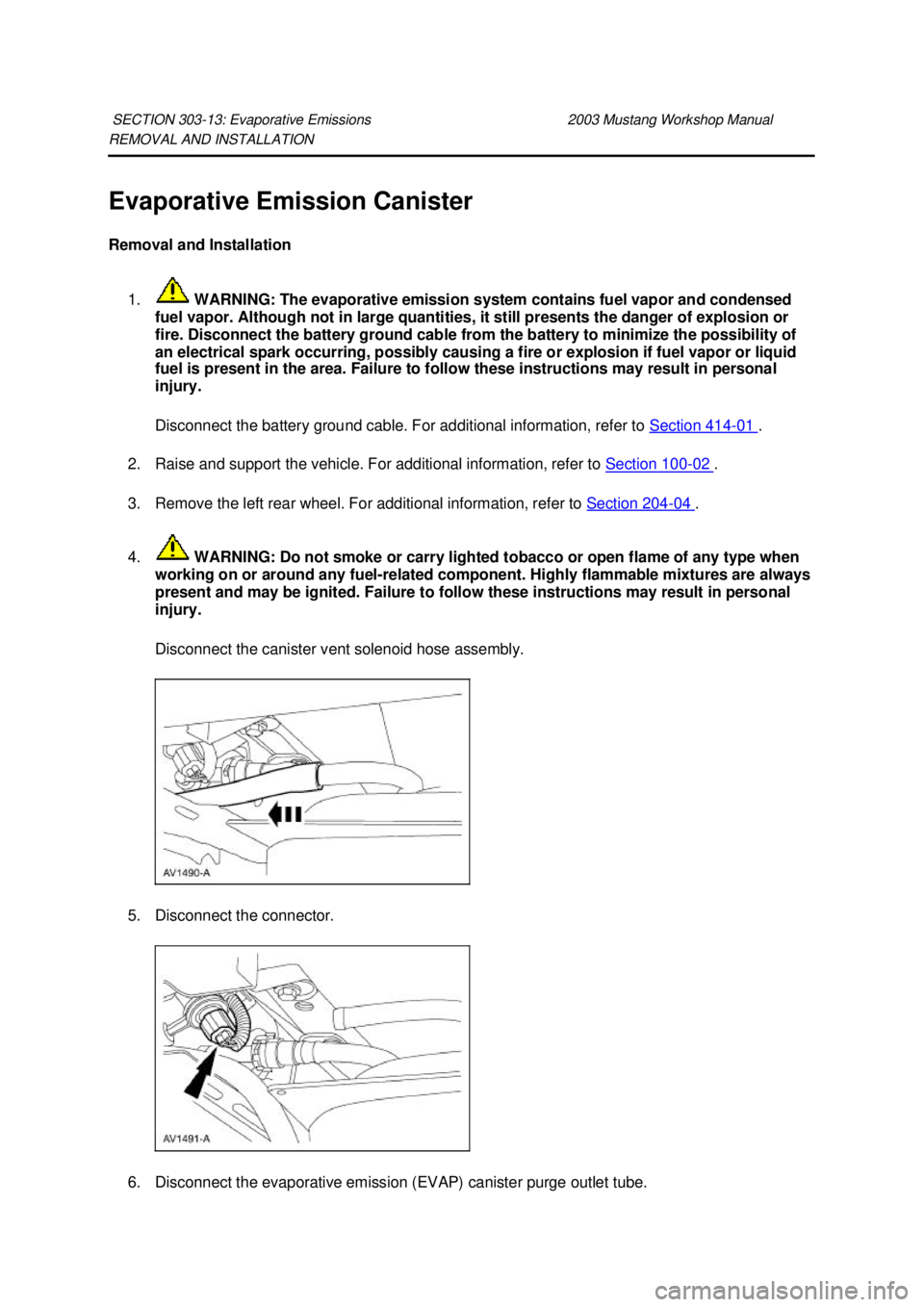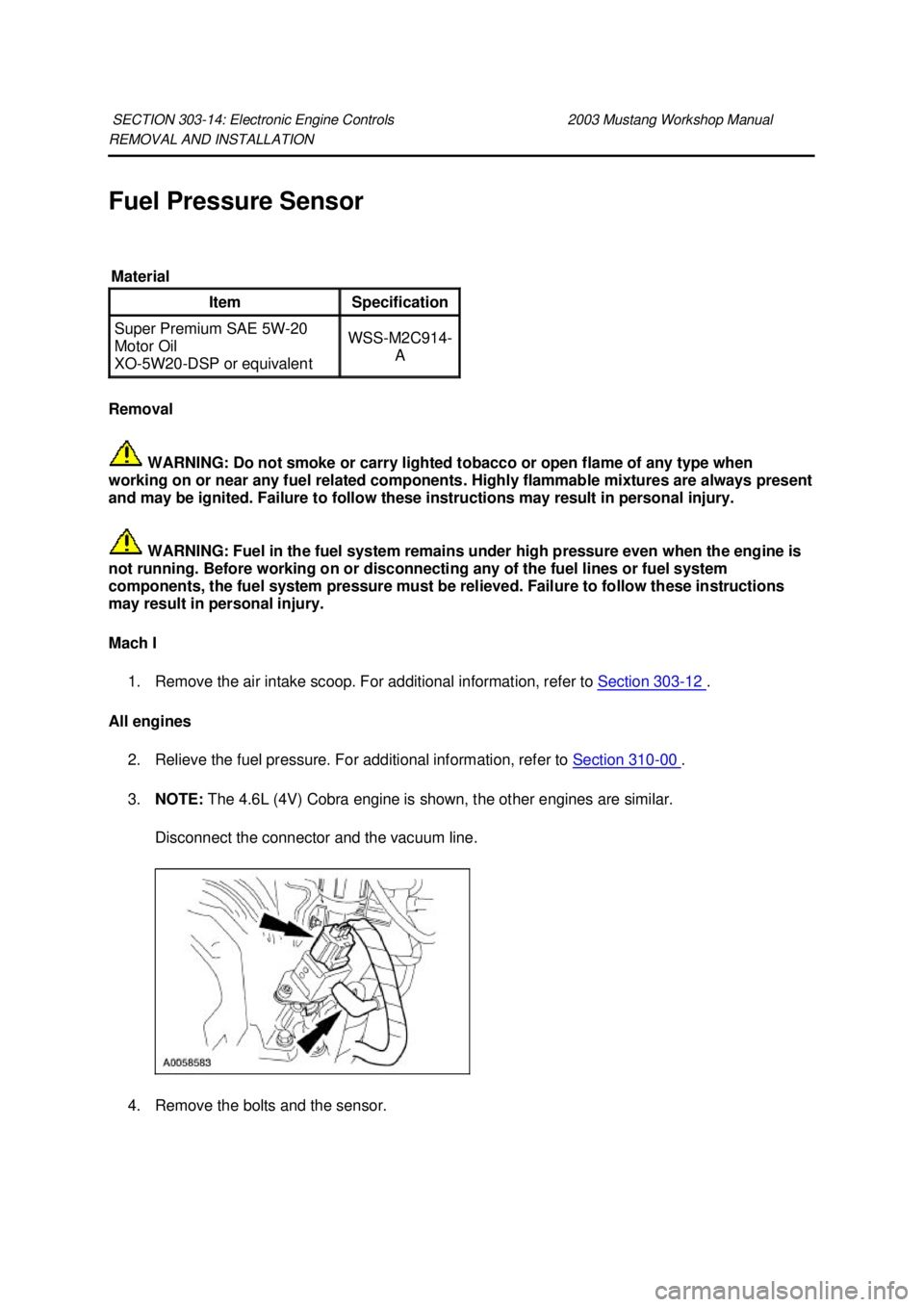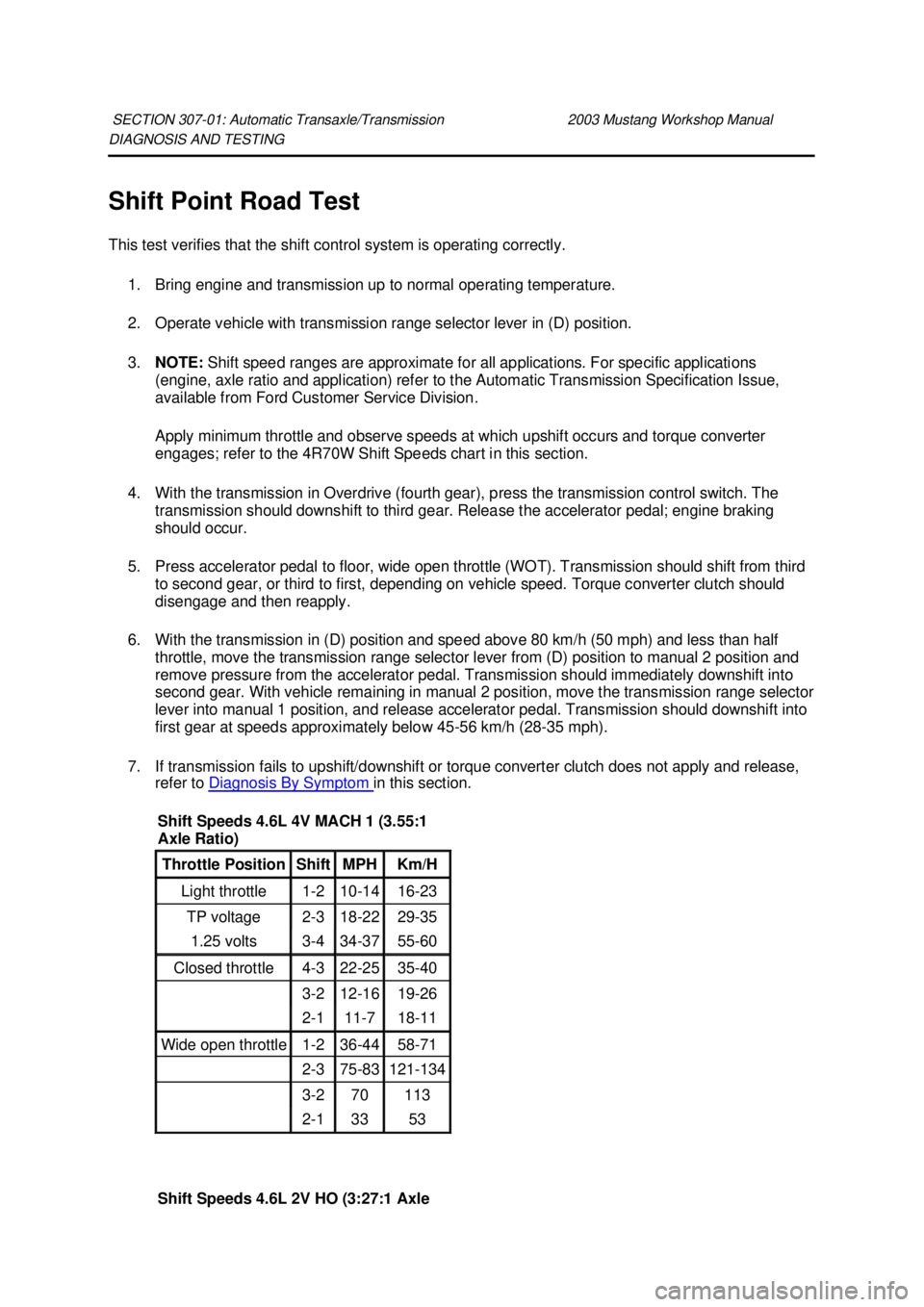Page 2078 of 4378
8. Inspect for overheating.
�zThis can be identified by a white or light gray insulator with small black or gray brown
spots and with bluish- burnt appearance of the electrodes.
�z This may be caused by engine overheating, wrong type of fuel, loose spark plugs, too hot
a plug, low fuel pump pressure or incorrect ignition timing.
�z Install a new spark plug.
9. Inspect for fused spot deposits. �zThis can be identified by melted or spotty deposits resembling bubbles or blisters.
�z This may be caused by sudden acceleration.
�z Clean the spark plug.
Installation 1. Adjust the spark plug gap as necessary. �K�l�j . 3 �b�a
42003 Mustang Workshop Manual
18. 11. 2011file:///C:/Ford/2000 - 2004/tsocache/SHEF_4464/S3B~us~en~ ...
Page 2086 of 4378
7.
NOTE: Verify that the ignition coil spring is correctly located inside the ignition coil boot and that
there is no damage to the tip of the boot.
To install, reverse the removal procedure.
�zApply a light coat of dielectric grease to the inside of the ignition coil boots. �K�l�j . 3 �b�a
32003 Mustang Workshop Manual
18. 11. 2011file:///C:/Ford/2000 - 2004/tsocache/SHEF_4464/S3B~us~en~ ...
Page 2179 of 4378

REMOVAL AND INSTALLATION
Evaporative Emission Canister
Removal and Installation
1. WARNING: The evaporative emission system contains fuel vapor and condensed
fuel vapor. Although not in large quantities, it still presents the danger of explosion or
fire. Disconnect the battery ground cable from the battery to minimize the possibility of
an electrical spark occurring, possibly causing a fire or explosion if fuel vapor or liquid
fuel is present in the area. Failure to follow these instructions may result in personal
injury.
Disconnect the battery ground cable. For additional information, refer to Section 414 - 01 .
2. Raise and support the vehicle. For additional information, refer to Section 100 - 02 .
3. Remove the left rear wheel. For additional information, refer to Section 204 - 04 .
4. WARNING: Do not smoke or carry lighted tobacco or open flame of any type when
working on or around any fuel- related component. Highly flammable mixtures are always
present and may be ignited. Failure to follow these instructions may result in personal
injury.
Disconnect the canister vent solenoid hose assembly.
5. Disconnect the connector.
6. Disconnect the evaporative emission (EVAP) canister purge outlet tube.
SECTION 303-
13: Evaporative Emissions 2003 Mustang Workshop Manual �K�l�j . 1 �b�a
32003 Mustang Workshop Manual
18. 11. 2011file:///C:/Ford/2000 - 2004/tsocache/SHEF_4464/S3B~us~en~ ...
Page 2183 of 4378
7.
WARNING: Do not smoke or carry lighted tobacco or open flame of any type when
working on or around any fuel- related component. Highly flammable mixtures are always
present and may be ignited. Failure to follow these instructions may result in personal
injury.
Disconnect the evaporative emission (EVAP) canister purge outlet tube.
8. Disconnect the EVAP return tube.
9. Remove the nuts and the EVAP canister purge valve. �K�l�j . 2 �b�a
32003 Mustang Workshop Manual
18. 11. 2011file:///C:/Ford/2000 - 2004/tsocache/SHEF_4464/S3B~us~en~ ...
Page 2249 of 4378

REMOVAL AND INSTALLATION
Fuel Pressure Sensor
Removal
WARNING: Do not smoke or carry lighted tobacco or open flame of any type when
working on or near any fuel related components. Highly flammable mixtures are always present
and may be ignited. Failure to follow these instructions may result in personal injury.
WARNING: Fuel in the fuel system remains under high pressure even when the engine is
not running. Before working on or disconnecting any of the fuel lines or fuel system
components, the fuel system pressure must be relieved. Failure to follow these instructions
may result in personal injury.
Mach I
1. Remove the air intake scoop. For additional information, refer to Section 303 - 12 .
All engines 2. Relieve the fuel pressure. For additional information, refer to Section 310 - 00 .
3. NOTE: The 4.6L (4V) Cobra engine is shown, the other engines are similar.
Disconnect the connector and the vacuum line. 4. Remove the bolts and the sensor. SECTION 303-
14: Electronic Engine Controls 2003 Mustang Workshop Manual Material
Item Specification
Super Premium SAE 5W-20
Motor Oil
XO- 5W20- DSP or equivalent WSS-
M2C914-
A �K�l�j . 1 �b�a
22003 Mustang Workshop Manual
18. 11. 2011file:///C:/Ford/2000 - 2004/tsocache/SHEF_4464/S3B~us~en~ ...
Page 2259 of 4378
A = Applied
H = Holding
O/R = Overrunning (Overdrive)
Reverse (R) A A
Park Engine
Running A
Stall Speed
Application Min. Max.
3.8L engine 2,240 2,619
4.6L 2V engine 2,339 2,738
4.6L 4V MACH 1 engine 2,375 2,767
Shift Speeds 4.6L 4V MACH 1 (3.55:1
Axle Ratio) Throttle Position Shift MPH Km/H
Light throttle 1-
2 10-14 16-23
TP voltage 2-
3 18-22 29-35
1.25 volts 3-
4 34-37 55-60
Closed throttle 4-
3 22-25 35-40
3-2 12-16 19-26
2-1 11-7 18-11
Wide open throttle 1-
2 36-44 58-71
2-3 75-83 121-134
3-2 70 113
2-1 33 53
Shift Speeds 4.6L 2V HO (3:27:1 Axle
Ratio) Throttle Position Shift MPH Km/H
Light throttle 1-
2 9-12 14-19
TP voltage 2-
3 14-18 23-29
1.25 volts 3-
4 36-38 58-61
Closed throttle 4-
3 26-22 42-35
3-2 15-11 24-18
2-1 12-8 19-13
Wide open throttle 1-
2 29-44 47-71 �K�l�j . 2 �b�a
62003 Mustang Workshop Manual
18. 11. 2011file:///C:/Ford/2000 - 2004/tsocache/SHEF_2748/S3B~us~en~ ...
Page 2260 of 4378
2-
3 74-80 119-129
3-2 73 117
2-1 32 51
Shift Speeds 3.8L (3:27:1 Axle Ratio) Throttle Position Shift MPH Km/H
Light throttle 1-
2 6-
10 10-16
TP voltage 2-
3 18-22 29-35
1.25 volts 3-
4 28–30 45–48
Closed throttle 4-
3 24-22 39-35
3-2 14-12 22-19
2-1 6-8 10-13
Wide open throttle 1-
2 36-40 58-64
2-3 74-70 119-112
3-2 67 108
2-1 28 45
Shift Speeds 3.8L (3:08:1 Axle Ratio) Throttle Position Shift MPH Km/H
Light throttle 1-
2 6-10 10-16
TP voltage 2-
3 16-20 26-32
1.25 volts 3-
4 38-42 61-68
Closed throttle 4-
3 34-28 55-45
3-2 16-13 26-21
2-1 9-
7 14-
11 Wide open throttle 1-
2 38-45 61-72
2-3 72-76 116-122
3-2 71 114
2-1 31 50
Sensor Resistance Readings Component Resistance (ohms)
SSA 20-
30 SSB 20-
30 EPC 2.48-
5.66 TCC 10-
16 OSS 1,026-
1,194
Selective Thrust Washer No.1 �K�l�j . 3 �b�a
62003 Mustang Workshop Manual
18. 11. 2011file:///C:/Ford/2000 - 2004/tsocache/SHEF_2748/S3B~us~en~ ...
Page 2309 of 4378

DIAGNOSIS AND TESTING
Shift Point Road Test
This test verifies that the shift control system is operating correctly.
1. Bring engine and transmission up to normal operating temperature.
2. Operate vehicle with transmission range selector lever in (D) position.
3. NOTE: Shift speed ranges are approximate for all applications. For specific applications
(engine, axle ratio and application) refer to the Automatic Transmission Specification Issue,
available from Ford Customer Service Division.
Apply minimum throttle and observe speeds at which upshift occurs and torque converter
engages; refer to the 4R70W Shift Speeds chart in this section.
4. With the transmission in Overdrive (fourth gear), press the transmission control switch. The transmission should downshift to third gear. Release the accelerator pedal; engine braking
should occur.
5. Press accelerator pedal to floor, wide open throttle (WOT). Transmission should shift from third to second gear, or third to first, depending on vehicle speed. Torque converter clutch should
disengage and then reapply.
6. With the transmission in (D) position and speed above 80 km/h (50 mph) and less than half throttle, move the transmission range selector lever from (D) position to manual 2 position and
remove pressure from the accelerator pedal. Transmission should immediately downshift into
second gear. With vehicle remaining in manual 2 position, move the transmission range selector
lever into manual 1 position, and release accelerator pedal. Transmission should downshift into
first gear at speeds approximately below 45- 56 km/h (28-35 mph).
7. If transmission fails to upshift/downshift or torque converter clutch does not apply and release, refer to Diagnosis By Symptom in this section.
SECTION 307-
01: Automatic Transaxle/Transmission 2003 Mustang Workshop Manual Shift Speeds 4.6L 4V MACH 1 (3.55:1
Axle Ratio)
Throttle Position Shift MPH Km/H
Light throttle 1-
2 10-14 16-23
TP voltage 2-
3 18-22 29-35
1.25 volts 3-
4 34-37 55-60
Closed throttle 4-
3 22-25 35-40
3-2 12-16 19-26
2-1 11-7 18-11
Wide open throttle 1-
2 36-44 58-71
2-3 75-83 121-134
3-2 70 113
2-1 33 53
Shift Speeds 4.6L 2V HO (3:27:1 Axle �K�l�j . 1 �b�a
32003 Mustang Workshop Manual
18. 11. 2011file:///C:/Ford/2000 - 2004/tsocache/SHEF_2748/S3B~us~en~ ...